View basket (0 items $0.00)

Healing Yoga for Cancer: Neuropathy
Your nervous system is made up of two parts that relay information between your brain and the rest of your body--the central nervous system (brain and spinal cord), and the peripheral nervous system (all other nerves. Neuropathy occurs when these nerves are damaged. Peripheral neuropathy, resulting from damage to nerves outside of the brain and spinal cord, can cause changes in sensation such as tingling, pain, numbness, and weakness especially prevalent in the arms, legs, hands, and feet. When it occurs in the lower body, there can also be issues with constipation or balance when proprioceptive feedback from the lower extremities is interrupted. Symptoms may be different from person to person depending on which nerves are damaged and the severity of the damage.
Why Do Cancer Patients Get Neuropathy?
Neuropathy can be caused by all allopathic cancer treatments and unfortunately, cannot be cured. Surgery causes neuropathy when nerves are disturbed and from the resulting inflammation. Radiation can cause neuropathy when treatment damages nerves, and neuropathy of the hands and arms is common in breast cancer patients who undergo radiation. Certain chemotherapy drugs can also cause neuropathy, especially at higher doses. The cancer tumor itself may also press on nerves and cause similar nerve damage and symptoms.
When sensory nerves are affected, those that control your sense of touch, you may feel tightness, discomfort when things touch your skin, numbness, an inability to feel temperature changes, tingling, burning, electric sensations, or pain in the hands in feet. You may even have challenges knowing where your hands or feet are in space (proprioception), which may cause balance issues or difficulty in grasping things.
When motor nerves are affected, those that relay information between the brain and body, you may have trouble walking because the feet and legs feel weak or heavy. Not only balance, but coordination may be compromised, and everyday activities such as dressing or using your phone may also be challenging as well. Symptoms may also worsen months or years after treatment ends.
When autonomic nerves are affected, those that govern bodily functions, you may have trouble regulating blood pressure, body temperature, swallowing and digestion, urination, and sexual function. It is important to inform your oncologist if you begin to experience any of these side effects.
Yoga and Neuropathy
The good news is that there are many ways that yoga can reduce the suffering associated with neuropathy. The relaxing effects of breathing and regular yoga practice can help you learn to handle the distraction and discomfort of neuropathy. And the movement aspect of the practice can help to reduce the uncomfortable sensations you may be experiencing.
Some mudras are said to circulate the vital force of the body (prana) and stimulate the extremities. In fact, several clinical trials are currently underway to explore the effectiveness of yoga to treat neuropathy in breast cancer patients.
Yoga Practice Tips
-
Do a little yoga each day to give yourself the time and space to heal, and to help make yoga a part of your life after cancer.
-
Stay mindful of the body and breath throughout the practice, and only move in a comfortable range of motion. If you become uncomfortable, dizzy, nauseous or breathless, stop immediately and rest for a few moments.
-
It is important to completely relax the muscles and rest in between active portions of each movement.
-
For this practice, a yoga mat, chair, and a yoga block, blanket or pillow will be helpful.
Repeat Intention with Vyana Vayu Mudra 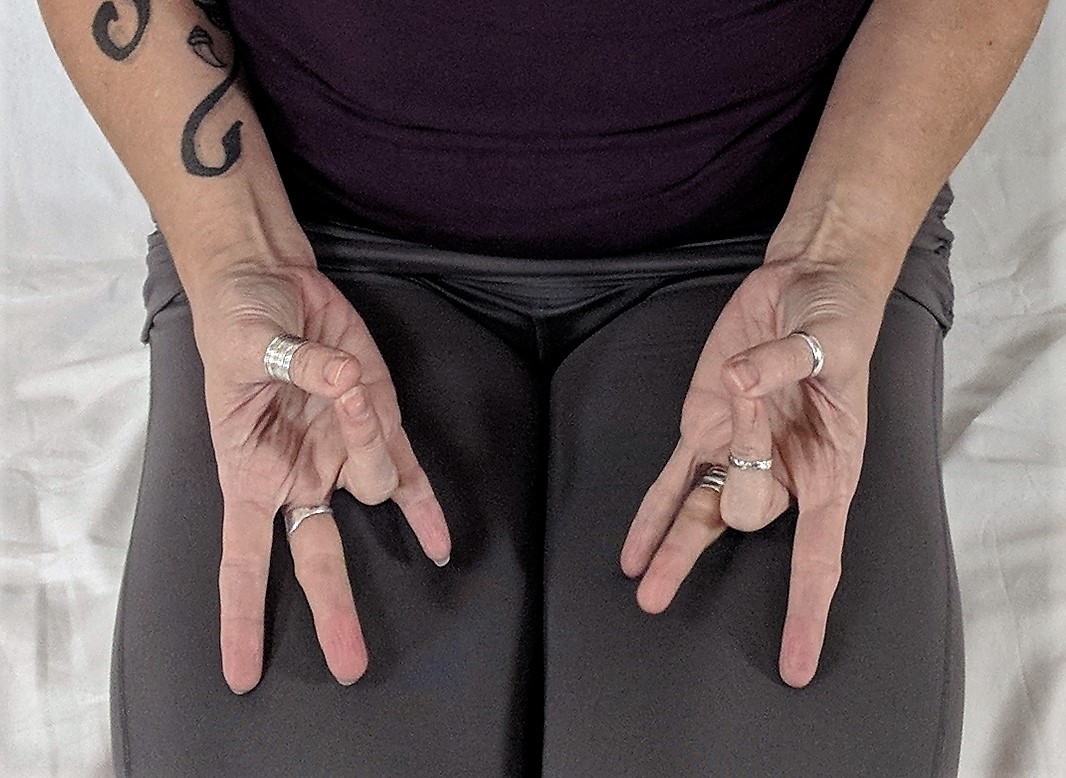
-
Begin in a comfortable seated position with your hands on your lap.
-
With your left hand, touch the tips of your thumb and middle finger together while extending your other fingers.
-
With your right hand, touch the tips of your thumb and ring fingers together while extending your other fingers.
-
Rest the backs of your hands on your thighs in Vyana Vayu Mudra. This gesture improves circulation to the extremities, enhances body awareness, and promotes the flow of vital energy through the body.
Setu Bandha Vinyasa (Bridge Flow) 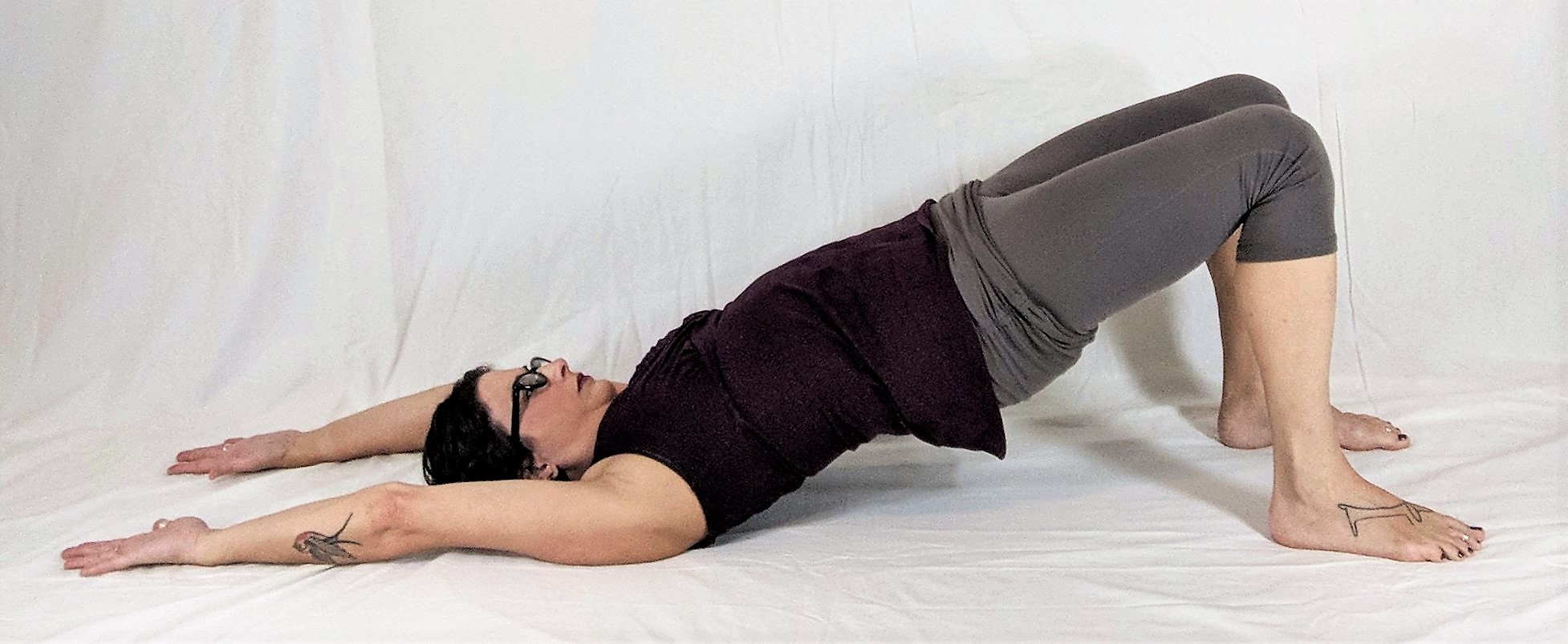
This reclining bridge flow is a simple series of movements that may help to increase pranic flow and circulation. It is best done on the floor but can also be done on a bed.
-
Lie on your back with your knees bent and your feet on the floor, hip-width apart.
-
As you inhale, press into your feet and raise your hips upward and your arms overhead. Either stop with the arms pointing directly upward or continue moving then toward the wall behind your head to a comfortable degree (as shown).
-
As you exhale, release your hips back to the floor and release your arms back to your sides. Try to land your hips and hands at the same time.
Repeat the entire sequence of movements at least five times, then rest for several breaths.
Vrksasana (Tree Pose)
This standard standing pose helps build body awareness, stability, and balance. 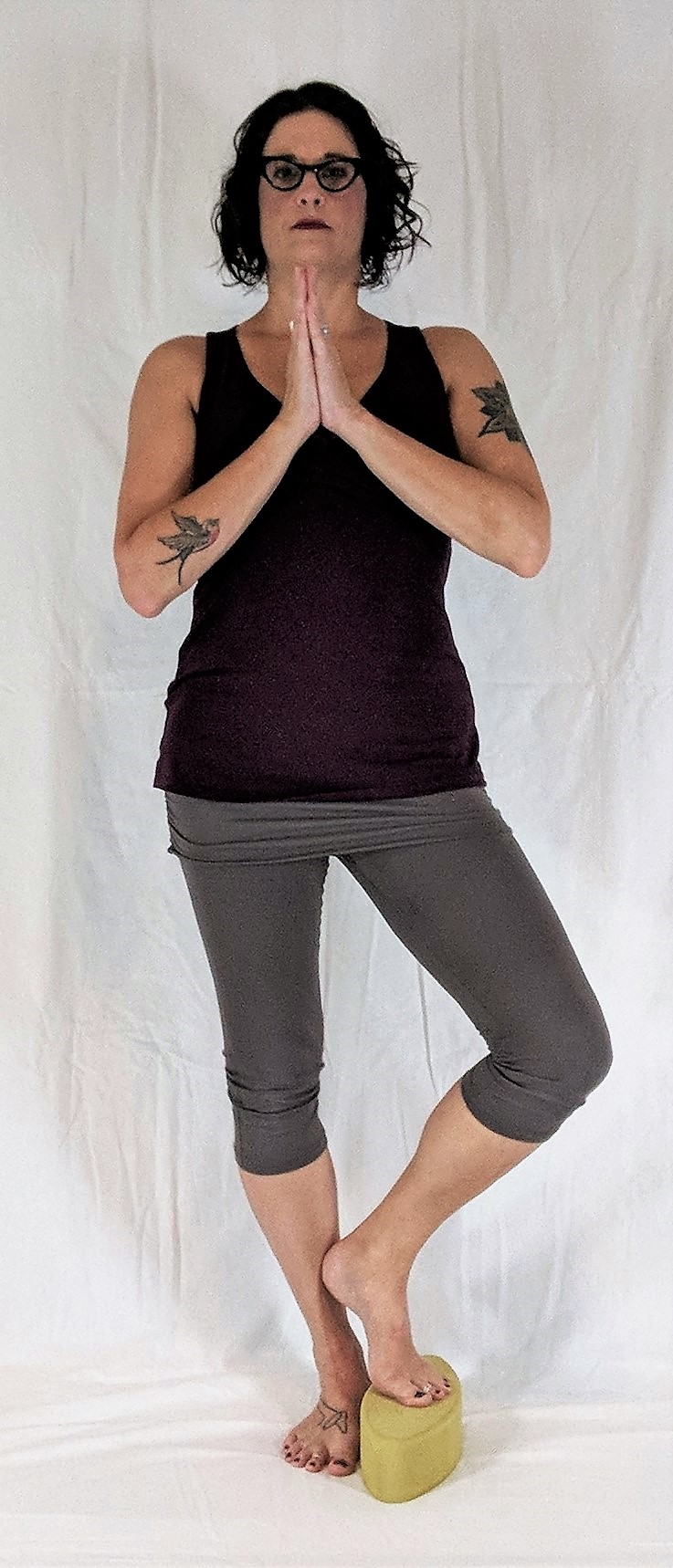
-
Begin standing with your feet hip-width apart and a yoga block between your feet on the lowest height. You may want to hold the back of a chair or tabletop for greater stability.
-
Lean your body weight into your right foot, without cocking your hip out to the side and keep both knees straight.
-
Pick up your left heel, then step the ball of your left foot on top of the block and rest your left heel against your right inner ankle. Point your left knee 45 degrees forward so that your pelvis stays facing forward.
-
Press the ball of your left big toe down into the floor and stare at something that will not move to assist you calming your mind and focusing your balance.
-
Place your hands together at your heart and take several long slow breaths.
-
When you feel like it is time to come down, step consciously down, take a few moments to move the standing foot and leg around before changing sides.
Virabhadrasana II Vinyasa (Warrior II Flow)
Moving through variations of Warrior II (Virabhadrasana II) can also help with stability, proprioception, strength, and balance.
-
Stand with your feet wide apart. You may want to hold the back of a chair or tabletop for greater stability.
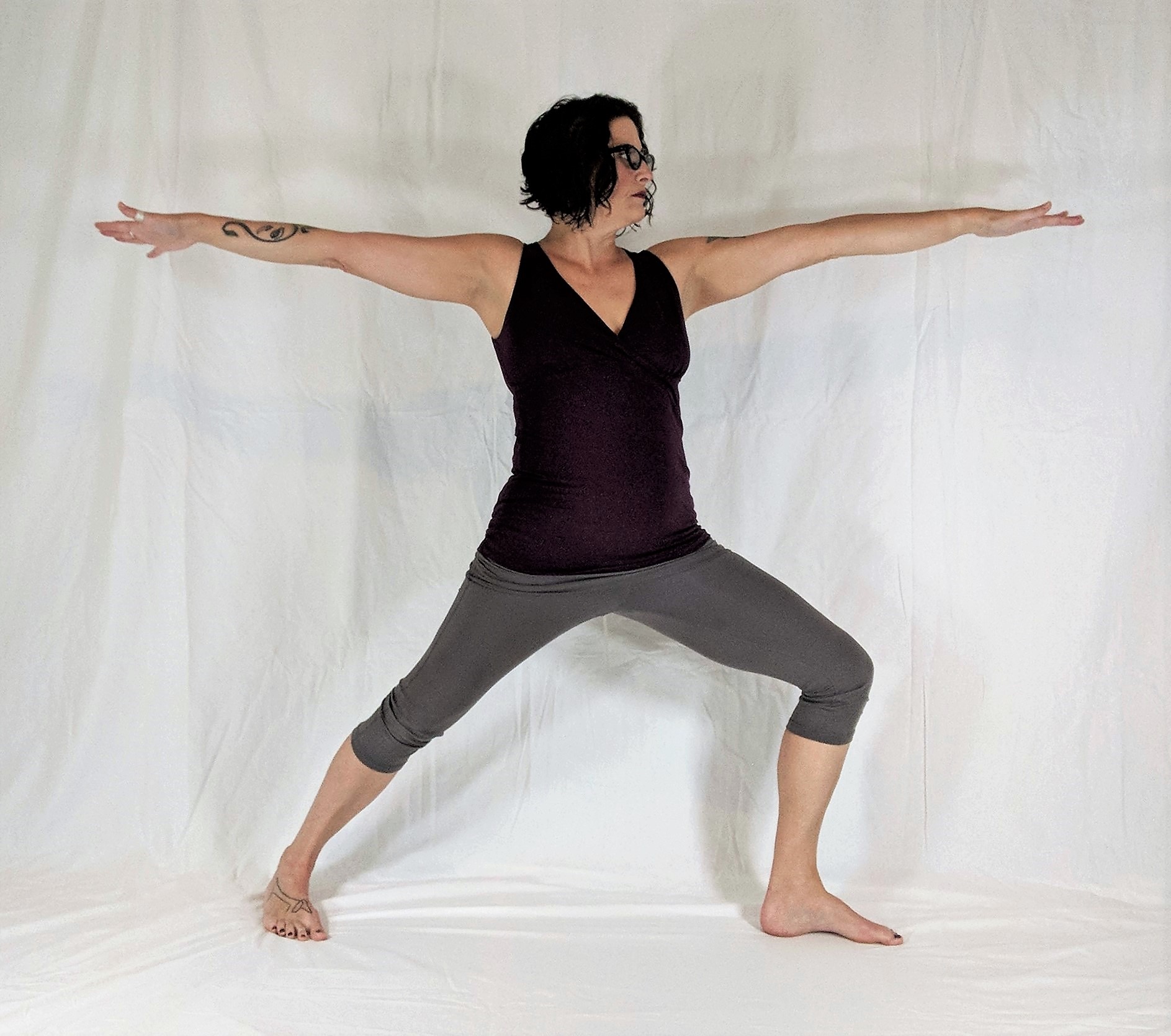
-
Turn your left foot out 90 degrees and your right foot in 30 degrees.
-
Make sure your hips turn slightly to the left (but not all the way forward) so that your front knee can track safely.
-
As you inhale, reach your arms out from shoulders.
-
As you exhale, bend your left knee toward the second toe of your left foot and come into Warrior II (Virabhadrasana II).
-
As you inhale, drop your right hand to your right thigh and raise your left arm diagonally upward into Viparita Virabhadrasana II (Reverse Warrior II).
-
As you exhale, release your arms back into a parallel reach.
-
As you inhale, straighten your front knee.
-
As you exhale, release your arms all the way down to your sides.
Take several breaths between sides and leave feet stepped apart if possible, for more stability work.
Nadi Shodhana (Alternate Nostril Breathing) 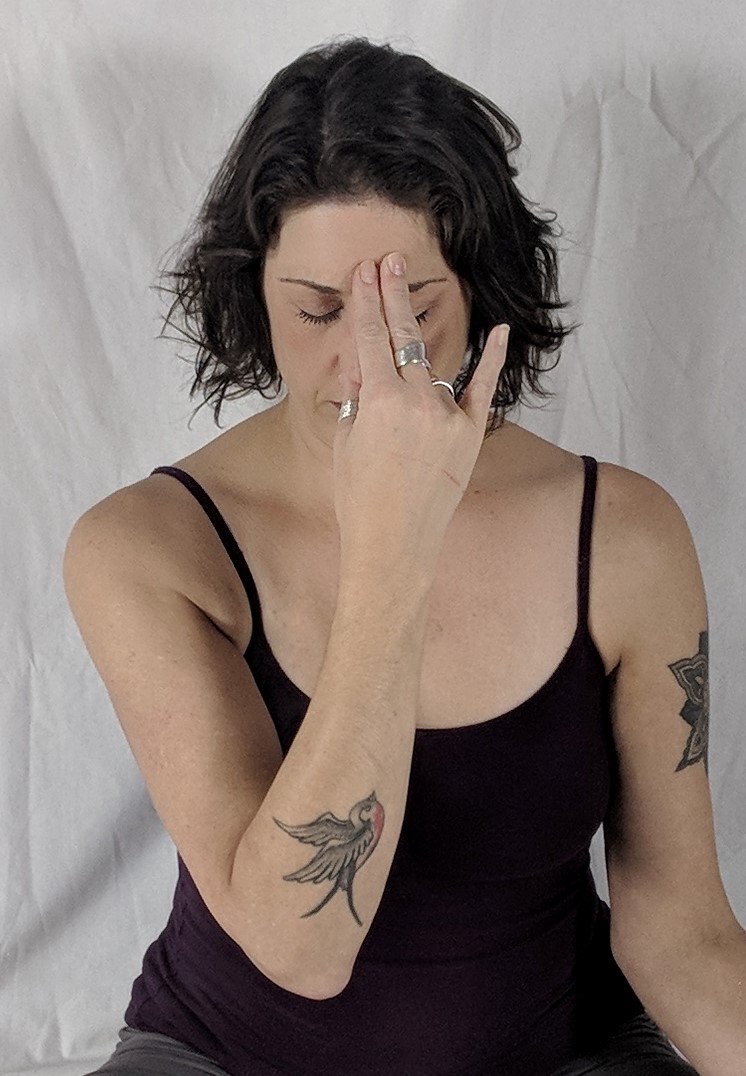
Breathing alternately into the right and left nostrils can help to calm the nervous system, which might make neuropathy symptoms seem less intense. It also increases communication between the right and left hemispheres of the brain to stimulate the central nervous system.
-
Begin seated comfortably and close your right nostril with your right thumb while inhaling through your left nostril.
-
Then change nostrils by closing your left nostril with your ring finger and exhale through your right nostril.
-
Breathe back in through your right nostril, then change your fingers again and breathe out through your left nostril.
Practice this breath for ten rounds and notice the physical and mental effects.
Body Scan 
The body scan, or rotation of consciousness, is a guided sensory journey through the different parts of the body. It increases body awareness, eliminates mental chatter, and engages the witness consciousness. You engage as many channels of communication as possible to keep the mind focused: auditory by listening to the teacher’s voice, speech by repeating the body part, visual by imagining the part externally, proprioceptive by feeling the part internally, kinesthetic by sensing movement from one place to the next.
The scan connects the origin of the motor nerves in the brain to the ending of the nerves in each part. As you go through the rotation of consciousness, you are activating parts of your brain associated with parts of your body, which in effect, relaxes the mind by relaxing the body.
-
Recline on a soft surface with room enough to lay with your legs outstretched (on a bolster or pillow if needed) and arms beside your body with your palms facing upwards. Try to stay awake without concentrating too intensely.
-
Use the following pattern to guide yourself through the body scan that follows:
Right-hand thumb … 1st finger … 2nd finger … 3rd finger … 4th finger … the palm of the hand … back of the hand … wrist … forearm … elbow … upper arm … right shoulder … armpit … chest … waist … hip … groin … buttock … thigh … knee … calf … ankle … heel … the sole of the foot … top of the foot … right big toe … 2nd toe … 3rd toe … 4th toe … 5th toe
Left-hand thumb … 1st finger … 2nd finger … 3rd finger … 4th finger … the palm of the hand … back of the hand … wrist … forearm … elbow … upper arm … left shoulder … armpit … chest … waist … hip … groin … buttock … thigh … knee … calf … ankle … heel … the sole of the foot … top of the foot … left big toe … 2nd toe … 3rd toe … 4th toe … 5th toe.
Move your awareness to the top of the head … forehead … right temple … left temple … right ear … left ear … right cheek … left cheek … right eyebrow … left eyebrow … eyebrow center … right eye … left eye … right nostril … left nostril … whole nose … upper lip … lower lip … chin … jaw … throat … right collarbone …left collarbone … right chest … left chest … heart center … upper abdomen … navel center… lower abdomen … right groin … left groin … the pelvic floor … tailbone … sacrum … right buttock … left buttock … the entire spine … right shoulder blade … left shoulder blade … back of the neck … back of the head … crown of the head.
Now take the body in parts … the whole right arm … the whole left arm … both arms together … the whole right leg … the whole left leg … both legs together … the entire torso … the face … the head … the body … the whole body … your entire body.
Here's another article from Cheryl Fenner Brown's series on Yoga for Cancer - Cancer and Insomnia: A Short, Relaxing Sequence to Put You on the Path to Sleep.
Study more about this topic with YogaUOnline and Tari Prinster - Introduction to Yoga for Cancer: Tapping Into the Body's Inherent Healing Wisdom.

 Cheryl Fenner Brown, C-IAYT, ERYT 500 works with cancer patients and people over 50 in central North Carolina. Her 700-hr Hatha training at Piedmont Yoga Studio and 1000-hr Integrative Yoga Therapy training inform her unique blend of alignment principles with subtle energy work, sound, mudra, and yoga nidra. She teaches classes, privates, self-care retreats and enjoys mentoring teachers in a 100-hr Adaptive Yoga Mentorship. Her Healing Yoga for Cancer Survivorship DVD is based on her feasibility study presented at IAYT's Symposium on Yoga Research and the Society of Integrative Oncology's annual conferences in 2015 and highlighted in Yoga Journal. From this work, she developed a 50-hr Healing Yoga for Cancer teacher training that is offered nationwide, find out more at www.yogacheryl.com.
Cheryl Fenner Brown, C-IAYT, ERYT 500 works with cancer patients and people over 50 in central North Carolina. Her 700-hr Hatha training at Piedmont Yoga Studio and 1000-hr Integrative Yoga Therapy training inform her unique blend of alignment principles with subtle energy work, sound, mudra, and yoga nidra. She teaches classes, privates, self-care retreats and enjoys mentoring teachers in a 100-hr Adaptive Yoga Mentorship. Her Healing Yoga for Cancer Survivorship DVD is based on her feasibility study presented at IAYT's Symposium on Yoga Research and the Society of Integrative Oncology's annual conferences in 2015 and highlighted in Yoga Journal. From this work, she developed a 50-hr Healing Yoga for Cancer teacher training that is offered nationwide, find out more at www.yogacheryl.com.
References
American Society of Clinical Oncology, “Nerve Problems or Neuropathy” Approved by Cancer.Net Editorial Board, 2018 https://www.cancer.net/coping-with-cancer/physical-emotional-and-social-effects-cancer/managing-physical-side-effects/nerve-problems-or-neuropathy
Journal of the American College of Surgeons, “Breast Cancer Patients’ Fear Exceeds Risk”, March 2013: Vol 216(3): 380-386.
Featured Courses








